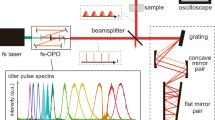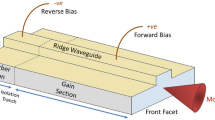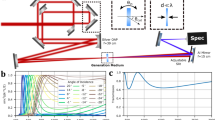Abstract
Real-time spectroscopy provides invaluable information about the evolution of dynamical processes, especially non-repetitive phenomena. Unfortunately, the continuous acquisition of rapidly varying spectra represents an extremely difficult challenge. One method, wavelength–time mapping, chirps the spectrum so that it can be measured using a single-shot oscilloscope1,2,3,4. Here, we demonstrate a method that overcomes a fundamental problem that has previously plagued wavelength–time spectroscopy: fine spectral resolution requires large dispersion, which is accompanied by extreme optical loss. The present technique uses an optically amplified wavelength–time transformation to beat the dispersion-loss trade-off and facilitate high-resolution, broadband, real-time applications. We show that this distributed amplification process can even be pumped by broadband noise, generating a wide gain bandwidth using a single pump source. We apply these techniques to demonstrate real-time stimulated Raman spectroscopy. Amplified wavelength–time Raman spectroscopy creates new opportunities for the study of chemical and physical dynamics in real time.
This is a preview of subscription content, access via your institution
Access options
Subscribe to this journal
Receive 12 print issues and online access
$209.00 per year
only $17.42 per issue
Buy this article
- Purchase on Springer Link
- Instant access to full article PDF
Prices may be subject to local taxes which are calculated during checkout




Similar content being viewed by others
References
Kelkar, P. V., Coppinger, F., Bhushan, A. S. & Jalali, B. Time-domain optical sensing. Electron. Lett. 35, 1661–1662 (1999).
Sanders, S. T. Wavelength-agile fiber laser using group-velocity dispersion of pulsed super-continua and application to broadband spectroscopy. Appl. Phys. B 75, 799–802 (2002).
Chou, J., Han, Y. & Jalali, B. Time–wavelength spectroscopy for chemical sensing. IEEE Photon. Technol. Lett. 16, 1140–1142 (2004).
Hult, J., Watt, R. S. & Kaminski, C. F. Dispersion measurement in optical fibers using supercontinuum pulses. J. Lightwave Technol. 25, 820–824 (2007).
Tong, Y. C., Chan, L. Y. & Tsang, H. K. Fibre dispersion or pulse spectrum measurement using a sampling oscilloscope. Electron. Lett. 33, 983–985 (1997).
Han, Y., Boyraz, O. & Jalali, B. Tera-sample per second real-time waveform digitizer. Appl. Phys. Lett. 87, 241116 (2005).
Watt, R. S. & Hult, J. in Proc. Europ. Combustion Meeting 1–4 (Chania, Greece, 2007).
Jackson, J. D. Classical Electrodynamics 3rd edn (Wiley, New York, 1999).
(ed. Laserna, J. J.) Modern Techniques in Raman Spectroscopy (Wiley, New York, 1996).
Eckhardt, G. et al. Stimulated Raman scattering from organic liquids. Phys. Rev. Lett. 9, 455–457 (1962).
Agrawal, G. P. Nonlinear Fiber Optics 3rd edn (Academic Press, San Diego, 2001).
Lallemand, P., Simova, P. & Bret, G. Pressure-induced line shift and collisional narrowing in hydrogen gas determined by stimulated Raman emission. Phys. Rev. Lett. 17, 1239–1241 (1966).
Owyoung, A. Coherent Raman gain spectroscopy using CW laser sources. IEEE J. Quant. Electron. QE-14, 192–203 (1978).
Wang, C.-S. Theory of stimulated Raman scattering. Phys. Rev. 182, 482–494 (1969).
Kukura, P., McCamant, D. W., Yoon, S., Wandschneider, D. B. & Mathies, R. A. Structural observation of the primary isomerization of vision with femtosecond-stimulated Raman. Science 310, 1006–1009 (2005).
McCamant, D. W., Kukura, P. & Mathies, R. A. Femtosecond time-resolved stimulated Raman spectroscopy: Application to the ultrafast internal conversion in β-carotene. J. Phys. Chem. A 107, 8208–8214 (2003).
Yoshizawa, M., Hattori, Y. & Kobayashi, T. Femtosecond time-resolved resonance Raman gain spectroscopy in polydiacetylene. Phys. Rev. B 49, 13259–13262 (1994).
Parker, J. H., Feldman, D. W. & Ashkin, M. Raman scattering by silicon and germanium. Phys. Rev. 155, 712–714 (1967).
Temple, P. A. & Hathaway, C. E. Multiphonon Raman spectrum of silicon. Phys. Rev. B 7, 3685–3697 (1973).
Boyraz, O. & Jalali, B. Demonstration of a silicon Raman laser. Opt. Express 12, 5269–5273 (2004).
Rong, H. et al. A continuous-wave Raman silicon laser. Nature 433, 725–728 (2005).
Claps, R., Dimitropoulos, D., Raghunathan, V., Han, Y. & Jalali, B. Observation of stimulated Raman amplification in silicon waveguides. Opt. Express 11, 1731–1739 (2003).
Xu, Q., Almeida, V. R. & Lipson, M. Time-resolved study of Raman gain in highly confined silicon-on-insulator waveguides. Opt. Express 12, 4437–4442 (2004).
Jones, R. et al. Net continuous wave optical gain in a low loss silicon-on-insulator waveguide by stimulated Raman scattering. Opt. Express 13, 519–525 (2005).
Solli, D. R. & Jalali, B. in CLEO/QELS 2007 Technical Digest, CMB3, 1–2 (OSA, Washington DC, 2007).
Stolen, R. H. & Ippen, E. P. Raman gain in glass optical waveguides. Appl. Phys. Lett. 22, 276–278 (1973).
Islam, M. N. Raman amplifiers for telecommunications. IEEE J. Sel. Top. Quant. Electron. 8, 548–559 (2002).
Vakhshoori, D. et al. in OSA Trends in Optics and Photonics Vol. 86, OFC Conference, Technical Digest, PD47, 1–3 (OSA, Washington DC, 2003).
Keita, K., Delaye, P., Frey, R. & Roosen, G. Relative intensity noise transfer of large-bandwidth pump lasers in Raman fiber amplifiers. J. Opt. Soc. Am. B 23, 2479–2485 (2006).
Acknowledgements
We thank P. Koonath for helpful discussions.
Author information
Authors and Affiliations
Corresponding author
Rights and permissions
About this article
Cite this article
Solli, D., Chou, J. & Jalali, B. Amplified wavelength–time transformation for real-time spectroscopy. Nature Photon 2, 48–51 (2008). https://doi.org/10.1038/nphoton.2007.253
Received:
Accepted:
Published:
Issue Date:
DOI: https://doi.org/10.1038/nphoton.2007.253
This article is cited by
-
Near-infrared spectroscopy of low-transmittance samples by a high-power time-stretch spectrometer using an arrayed waveguide grating (AWG)
Scientific Reports (2023)
-
The predictive model for the universe rotation axis identification upon applying the solar system coordinate net in the Milky Way galaxy
Indian Journal of Physics (2022)
-
Predictive models for identification of Milky Way Galaxy digital images
Indian Journal of Physics (2021)
-
Real-time gap-free dynamic waveform spectral analysis with nanosecond resolutions through analog signal processing
Nature Communications (2020)
-
From self-organization in relativistic electron bunches to coherent synchrotron light: observation using a photonic time-stretch digitizer
Scientific Reports (2019)



